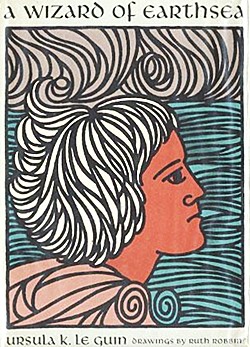
A Wizard of Earthsea is a fantasy novel written by American author Ursula K. Le Guin and first published by the small press Parnassus in 1968. It is regarded as a classic of children's literature and of fantasy, within which it is widely influential. The story is set in the fictional archipelago of Earthsea and centers on a young mage named Ged, born in a village on the island of Gont. He displays great power while still a boy and joins a school of wizardry, where his prickly nature drives him into conflict with a fellow student. During a magical duel, Ged's spell goes awry and releases a shadow creature that attacks him. The novel follows Ged's journey as he seeks to be free of the creature.

Ursula Kroeber Le Guin was an American author best known for her works of speculative fiction, including science fiction works set in her Hainish universe, and the Earthsea fantasy series. Her work was first published in 1959, and her literary career spanned nearly sixty years, producing more than twenty novels and over a hundred short stories, in addition to poetry, literary criticism, translations, and children's books. Frequently described as an author of science fiction, Le Guin has also been called a "major voice in American Letters". Le Guin said she would prefer to be known as an "American novelist".

Lloyd Chudley Alexander was an American author of more than 40 books, primarily fantasy novels for children and young adults. Over his seven-decade career, Alexander wrote 48 books, and his work has been translated into 20 languages. His most famous work is The Chronicles of Prydain, a series of five high fantasy novels whose conclusion, The High King, was awarded the 1969 Newbery Medal for excellence in American children's literature. He won U.S. National Book Awards in 1971 and 1982.

Steven Karl Zoltán Brust is an American fantasy and science fiction author of Hungarian descent. He is best known for his series of novels about the assassin Vlad Taltos, one of a disdained minority group of humans living on a world called Dragaera. His recent novels also include The Incrementalists (2013) and its sequel The Skill of Our Hands (2017), with co-author Skyler White.
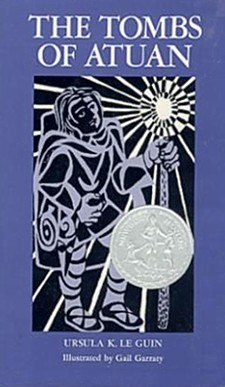
The Tombs of Atuan is a fantasy novel by the American author Ursula K. Le Guin, first published in the Winter 1970 issue of Worlds of Fantasy, and published as a book by Atheneum Books in 1971. It is the second book in the Earthsea series after A Wizard of Earthsea (1969). The Tombs of Atuan was a Newbery Honor Book in 1972.
"The Scouring of the Shire" is the penultimate chapter of J. R. R. Tolkien's fantasy The Lord of the Rings. The Fellowship hobbits, Frodo, Sam, Merry, and Pippin, return home to the Shire to find that it is under the brutal control of ruffians and their leader "Sharkey", revealed to be the Wizard Saruman. The ruffians have despoiled the Shire, cutting down trees and destroying old houses, as well as replacing the old mill with a larger one full of machinery which pollutes the air and the water. The hobbits rouse the Shire to rebellion, lead their fellow hobbits to victory in the Battle of Bywater, and end Saruman's rule.

Margaret Astrid Lindholm Ogden, known by her pen names Robin Hobb and Megan Lindholm, is an American writer of speculative fiction. As Hobb, she is best known for her fantasy novels set in the Realm of the Elderlings, which comprise the Farseer, Liveship Traders and Tawny Man trilogies, the Rain WildChronicles, and the Fitz and the Fool trilogy. Lindholm's writing includes the urban fantasy novel Wizard of the Pigeons and science fiction short stories, among other works. As of 2018, her fiction has been translated into 22 languages and sold more than 4 million copies.

The Mythopoeic Awards for literature and literary studies are given annually for outstanding works in the fields of myth, fantasy, and the scholarly study of these areas. Established by the Mythopoeic Society in 1971, the Mythopoeic Fantasy Award is given for "fiction in the spirit of the Inklings", and the Scholarship Award for non-fiction work. The award is a statuette of a seated lion, with a plaque on the base. It has drawn resemblance to, and is often called, the "Aslan".

The Farseer trilogy is a series of fantasy novels by American author Robin Hobb, published from 1995 to 1997. It is often described as epic fantasy, and as a character-driven and introspective work. Set in and around the fictional realm of the Six Duchies, it tells the story of FitzChivalry Farseer, an illegitimate son of a prince who is trained as an assassin. Political machinations within the royal family threaten his life, and the kingdom is beset by naval raids. Fitz possesses two forms of magic: the telepathic Skill that runs in the royal line, and the socially despised Wit that enables bonding with animals. The series follows his life as he seeks to restore stability to the kingdom.

Fantasy is a genre of speculative fiction involving magical elements, typically set in a fantasy world and usually inspired by mythology or folklore. The term "fantasy" can also be used to describe a "work of this genre", usually literary.
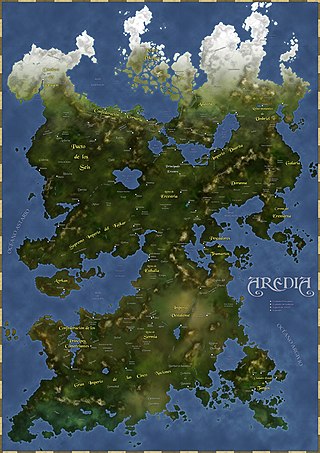
Fantasy cartography, fictional map-making, or geofiction is a type of map design that visually presents an imaginary world or concept, or represents a real-world geography in a fantastic style. Fantasy cartography usually manifests from worldbuilding and often corresponds to narratives within the fantasy and science fiction genres. Stefan Ekman says, "a [regular] map re-presents what is already there; a fictional map is often primary – to create the map means, largely, to create the world of the map."
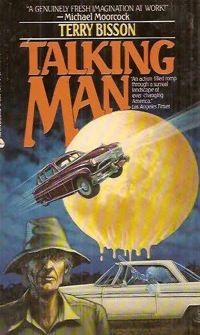
Talking Man is a 1986 fantasy novel by American author Terry Bisson. The book tells the story of a Kentucky mechanic called "Talking Man". Talking Man is a wizard who creates his own world.
Character pairing in The Lord of the Rings is a literary device used by J. R. R. Tolkien, a Roman Catholic, to express some of the moral complexity of his major characters in his heroic romance, The Lord of the Rings. Commentators have noted that the format of a fantasy does not lend itself to subtlety of characterisation, but that pairing allows inner tensions to be expressed as linked opposites, including, in a psychoanalytic interpretation, those of Jungian archetypes.

The Windsingers is the debut fantasy series of American author Robin Hobb under her pen name Megan Lindholm, published between 1983 and 1989. It follows a woman named Ki as she recovers from the death of her family and forms a companionship with a man called Vandien. Over the course of four books, the duo face fictional creatures including harpies, who can grant visions of the dead, and Windsingers, beings who can control the weather through music. The characters Ki and Vandien first appeared in a short story in Amazons!, an anthology focused on female heroes in fantasy. The anthology won a World Fantasy Award in 1980, and Lindholm's story drew the interest of an editor at Ace Books, leading to the development of the series.
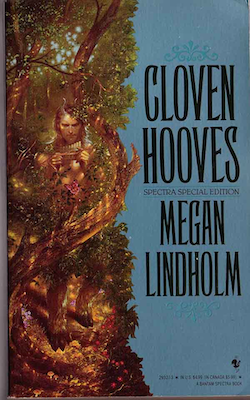
Cloven Hooves is a 1991 fantasy novel by Megan Lindholm, published in the US by Bantam Spectra. UK and French editions have also been released. The book went out of print in the US, where it was unavailable for nearly thirty years before a Voyager Classics edition was issued in 2019.
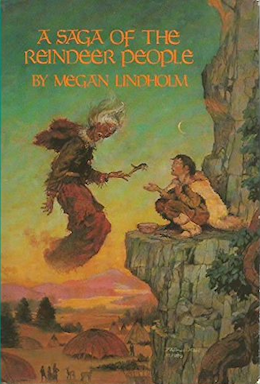
The Reindeer People is a prehistoric fiction series by American author Megan Lindholm, published in 1988 by Ace Books.
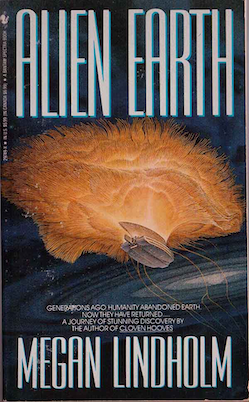
Alien Earth is a science fiction novel by American author Megan Lindholm, published in 1992 by Bantam Spectra. A French translation has been released. In the United States, it went out of print in 1992 and was unavailable until an ebook edition was released in 2011.
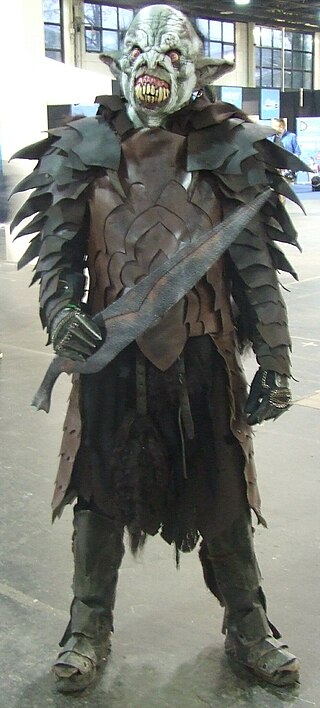
Although fantasy had long existed in various forms around the world before his time, J. R. R. Tolkien has been called the "father of fantasy", and The Lord of the Rings its centre. That novel, published in 1954–5, enormously influenced fantasy writing, establishing in particular the form of high or epic fantasy, set in a secondary or fantasy world in an act of mythopoeia. The book was distinctive at the time for its considerable length, its "epic" feel with a cast of heroic characters, its wide geography, and its battles. It involved an extensive history behind the action, an impression of depth, multiple sentient races and monsters, and powerful talismans. The story is a quest, with multiple subplots. The novel's success demonstrated that the genre was commercially distinct and viable.
















